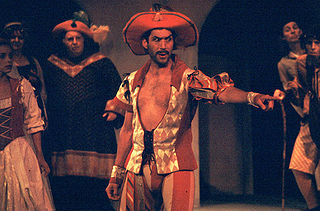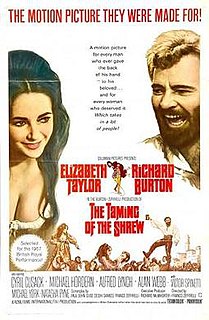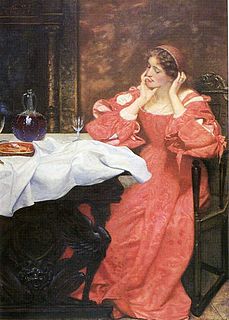
The Taming of the Shrew is a comedy by William Shakespeare, believed to have been written between 1590 and 1592. The play begins with a framing device, often referred to as the induction, in which a mischievous nobleman tricks a drunken tinker named Christopher Sly into believing he is actually a nobleman himself. The nobleman then has the play performed for Sly's diversion.

Kiss Me, Kate is a musical written by Bella and Samuel Spewack with music and lyrics by Cole Porter. The story involves the production of a musical version of William Shakespeare's The Taming of the Shrew and the conflict on and off-stage between Fred Graham, the show's director, producer, and star, and his leading lady, his ex-wife Lilli Vanessi. A secondary romance concerns Lois Lane, the actress playing Bianca, and her gambler boyfriend, Bill, who runs afoul of some gangsters. The original production starred Alfred Drake, Patricia Morison, Lisa Kirk and Harold Lang.

Petruchio is the male protagonist in Shakespeare's The Taming of the Shrew. Petruchio is a fortune seeker who enters into a marriage with a strong-willed young woman named Kate and then proceeds to "tame" her temperamental spirit. The role has attracted notable performers.
ShakespeaRe-Told is the umbrella title for a series of four television adaptations of William Shakespeare's plays broadcast on BBC One during November 2005. In a similar manner to the 2003 production of The Canterbury Tales, each play is adapted by a different writer, and relocated to the present day. The plays were produced in collaboration by BBC Northern Ireland and the central BBC drama department. In August 2006 the four films aired on BBC America.

Elizabeth "Lily" Brayton was an English actress and singer, known for her performances in Shakespeare plays and for her nearly 2,000 performances in the First World War hit musical Chu Chin Chow.
The Woman's Prize, or the Tamer Tamed is a Jacobean comedy written by John Fletcher. It was first published in the first Beaumont and Fletcher folio of 1647, though it was written several decades earlier. There is no doubt that the play is the work of Fletcher alone; his highly distinctive and characteristic pattern of linguistic preferences is continuous through the text.

Kiss Me Kate is a 1953 Metro-Goldwyn-Mayer film adaptation of the 1948 Broadway musical of the same name.

The Taming of the Shrew is a 1967 American-Italian romantic comedy film based on the play of the same name by William Shakespeare about a courtship between two strong-willed people. The film was directed by Franco Zeffirelli and stars Elizabeth Taylor and Richard Burton as Shakespeare's Kate and Petruchio.

Richard III (1699) is a history play written by Colley Cibber. It is based on William Shakespeare's Richard III, but reworked for Williamite audiences.

The Taming of the Shrew is a 1908 silent film directed by D. W. Griffith. It was based on Shakespeare's play of the same name.

The History of King Lear is an adaptation by Nahum Tate of William Shakespeare's King Lear. It first appeared in 1681, some seventy-five years after Shakespeare's version, and is believed to have replaced Shakespeare's version on the English stage in whole or in part until 1838.

Bianca Minola is a character in Shakespeare's The Taming of the Shrew (c.1590–1594). She is the younger daughter of Baptista Minola and the sister of Kate, the "shrew" of the title. The lovely Bianca has several admirers in the play, but Baptista has refused to allow her to marry until his shrewish daughter Kate has found a husband. When Kate marries, Bianca is united with her lover, Lucentio. Theatrically, Bianca is the ingenue in Shrew and the female lead in the play's subplot.

The Taming of the Shrew is a 1929 American pre-Code comedy film directed by Sam Taylor and starring Mary Pickford and her husband Douglas Fairbanks. It was the first sound film adaptation of the Shakespearean play of the same name. The film was adapted by Taylor from William Shakespeare's play.
The Taming of the Shrew is a 1957 opera in four acts, five scenes by Vissarion Shebalin to a libretto by the Soviet musicologist Abram Akimovich Gozenpud, based on the comedy by William Shakespeare. Gozenpud utilized very little of Shakespeare's original text in his libretto, and completely eliminated many of the secondary characters and subplots from the play. His libretto does match the spirit of Shakespeare's play in its use of wit, the genuine passion of the story's lovers, and mixture of both lofty and coarse language.
There have been numerous on screen adaptations of Shakespeare's The Taming of the Shrew. The best known cinematic adaptations are Sam Taylor's 1929 The Taming of the Shrew and Franco Zeffirelli's 1967 The Taming of the Shrew, both of which starred the most famous celebrity couples of their era; Mary Pickford and Douglas Fairbanks in 1929 and Elizabeth Taylor and Richard Burton in 1967. On television, perhaps the most significant adaptation is the 1980 BBC Television Shakespeare version, directed by Jonathan Miller and starring John Cleese and Sarah Badel.
The Taming of the Shrew in performance has had an uneven history. Popular in Shakespeare's day, the play fell out of favour during the seventeenth century, when it was replaced on the stage by John Lacy's Sauny the Scott. The original Shakespearean text was not performed at all during the eighteenth century, with David Garrick's adaptation Catharine and Petruchio dominating the stage. After over two hundred years without a performance, the play returned to the British stage in 1844, the last Shakespeare play restored to the repertory. However, it was only in the 1890s that the dominance of Catharine and Petruchio began to wain, and productions of The Shrew become more regular. Moving into the twentieth century, the play's popularity increased considerably, and it became one of Shakespeare's most frequently staged plays, with productions taking place all over the world. This trend has continued into the twenty-first century, with the play as popular now as it was when first written.
The Taming of the Shrew is a ballet in two acts choreographed by John Cranko to keyboard works by Domenico Scarlatti arranged and orchestrated by Kurt-Heinz Stolze. With scenery and costumes designed by Elizabeth Dalton, it was first presented as Der Widerspenstigen Zähmung by the Stuttgart Ballet at the Wṻrtembergische Staatstheater in Stuttgart on 16 March 1969.
The Taming of the Shrew is an opera in three acts by composer Vittorio Giannini. The work uses an English language libretto by Dorothy Fee and the composer which is based on William Shakespeare's play of the same name. The opera premiered at the Cincinnati Music Hall on January 31, 1953 in a concert performance starring Dorothy Short as Katharina, Robert Kircher as Petruchio, the Cincinnati Symphony Orchestra, and conductor Thor Johnson. Considered Giannini's most popular work, it was one of three finalists named for the Pulitzer Prize for Music in 1953.

Vinegar Girl is a 2016 novel by American author Anne Tyler. It is the third book of Random House's "Hogarth Shakespeare" project, in which contemporary novelists retell stories from Shakespeare's plays. Interviewed by Ron Charles in The Washington Post, Tyler said " 'The Katherina in Shakespeare’s play is insane... She’s shrieking at Petruchio from the moment she meets him. And he’s not much better. So you know I had to tone them down. I’m sure that somebody is out there, saying, ‘This isn’t a shrew at all.’ "

Katherina (Kate) Minola is a character in Shakespeare's The Taming of the Shrew. Katherina is the older daughter of Baptista Minola and the sister of Bianca, the "ingenue". Katherina is the "shrew" of the title and the main female lead. The story primarily follows Katherina and her "taming" by Petruchio. Katherina is a strong-willed and powerful female character, but by the end of the play she has been "tamed" by Petruchio and fits more into the role of a "good" wife.















